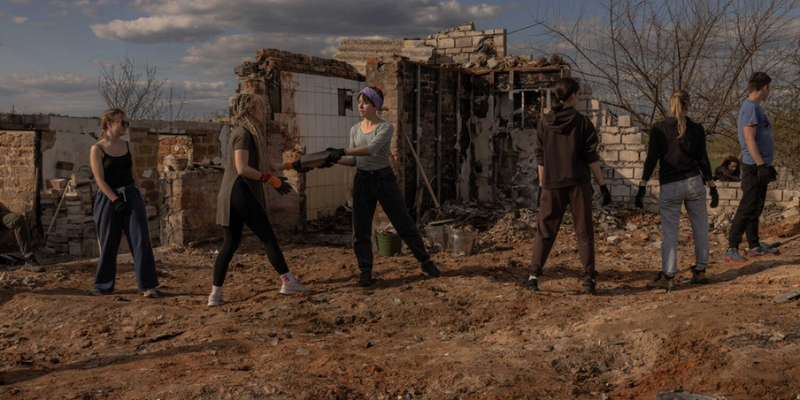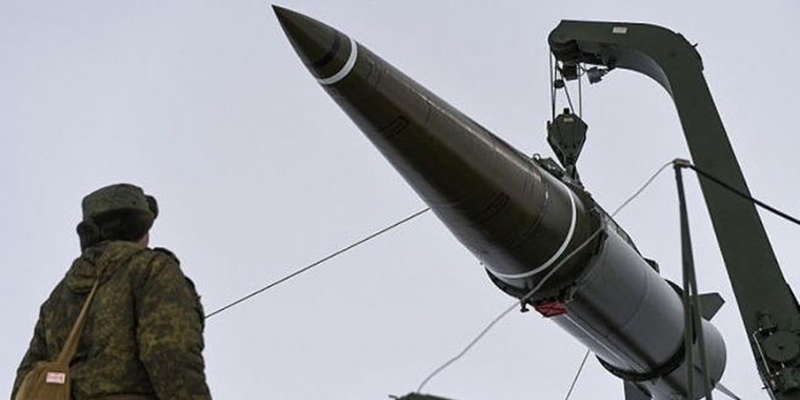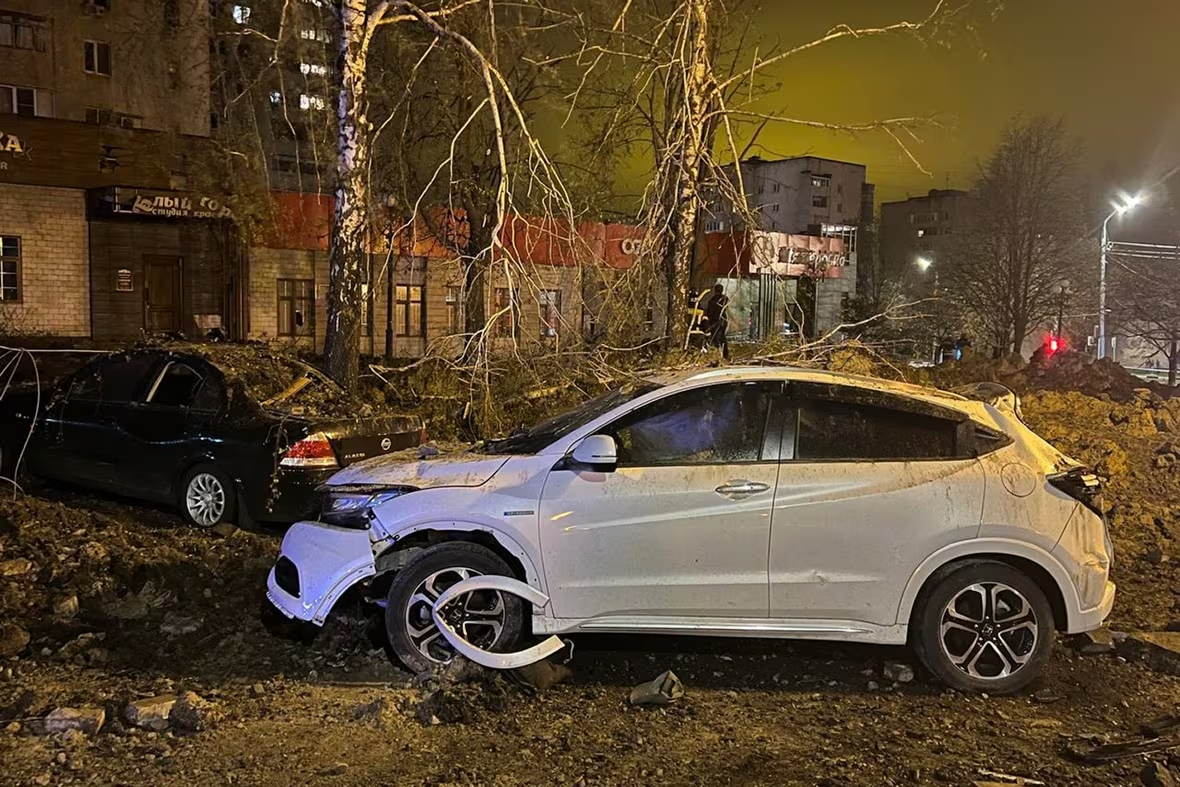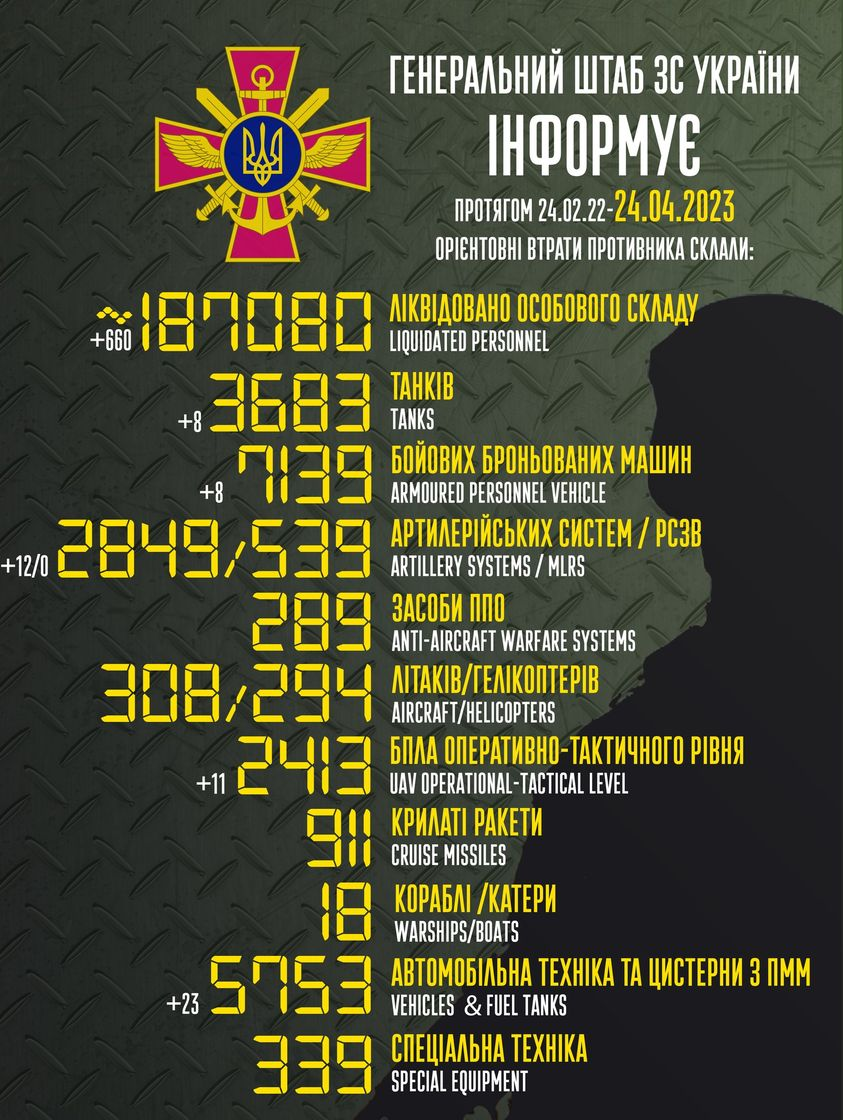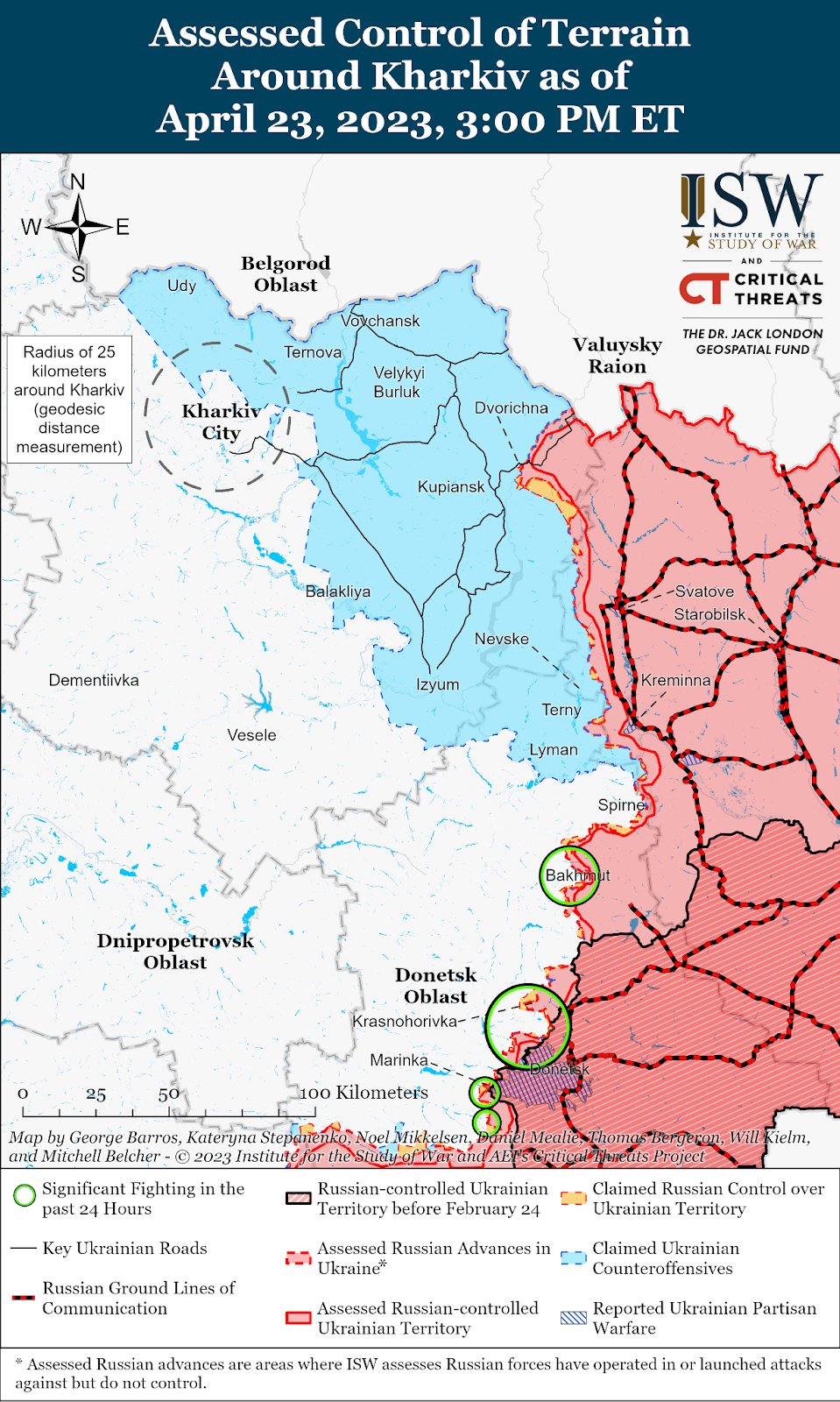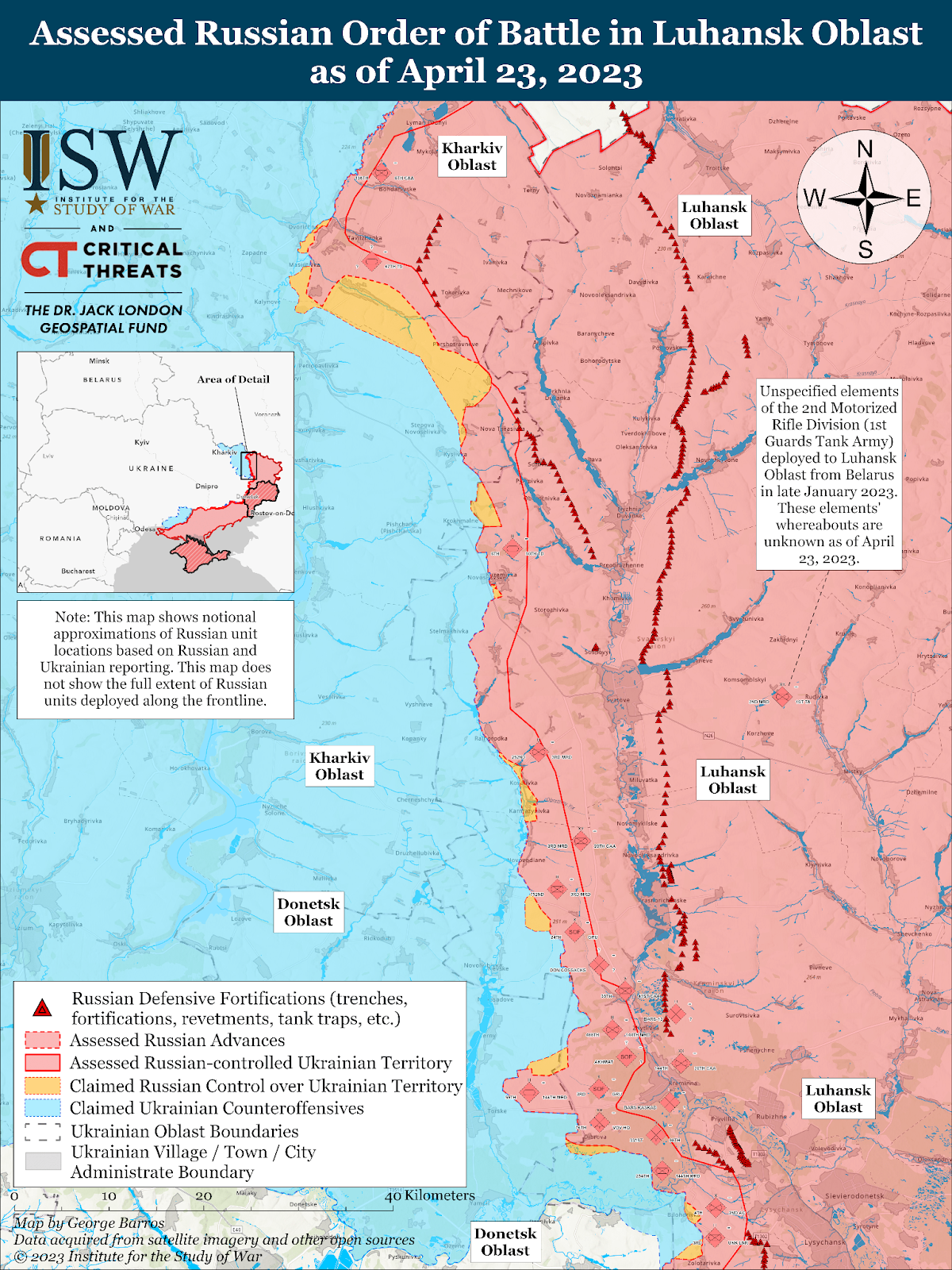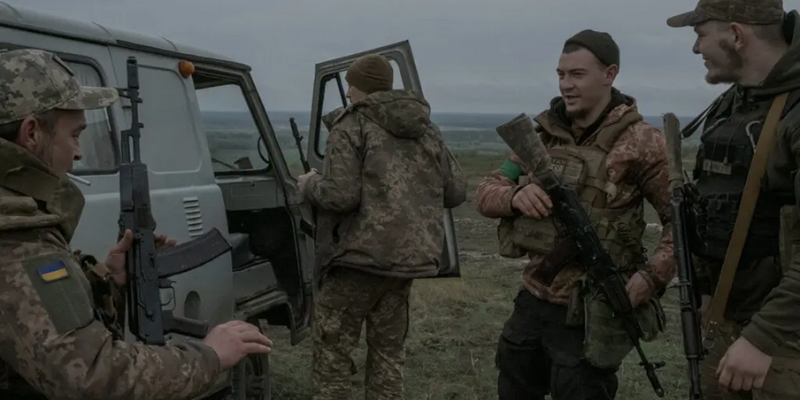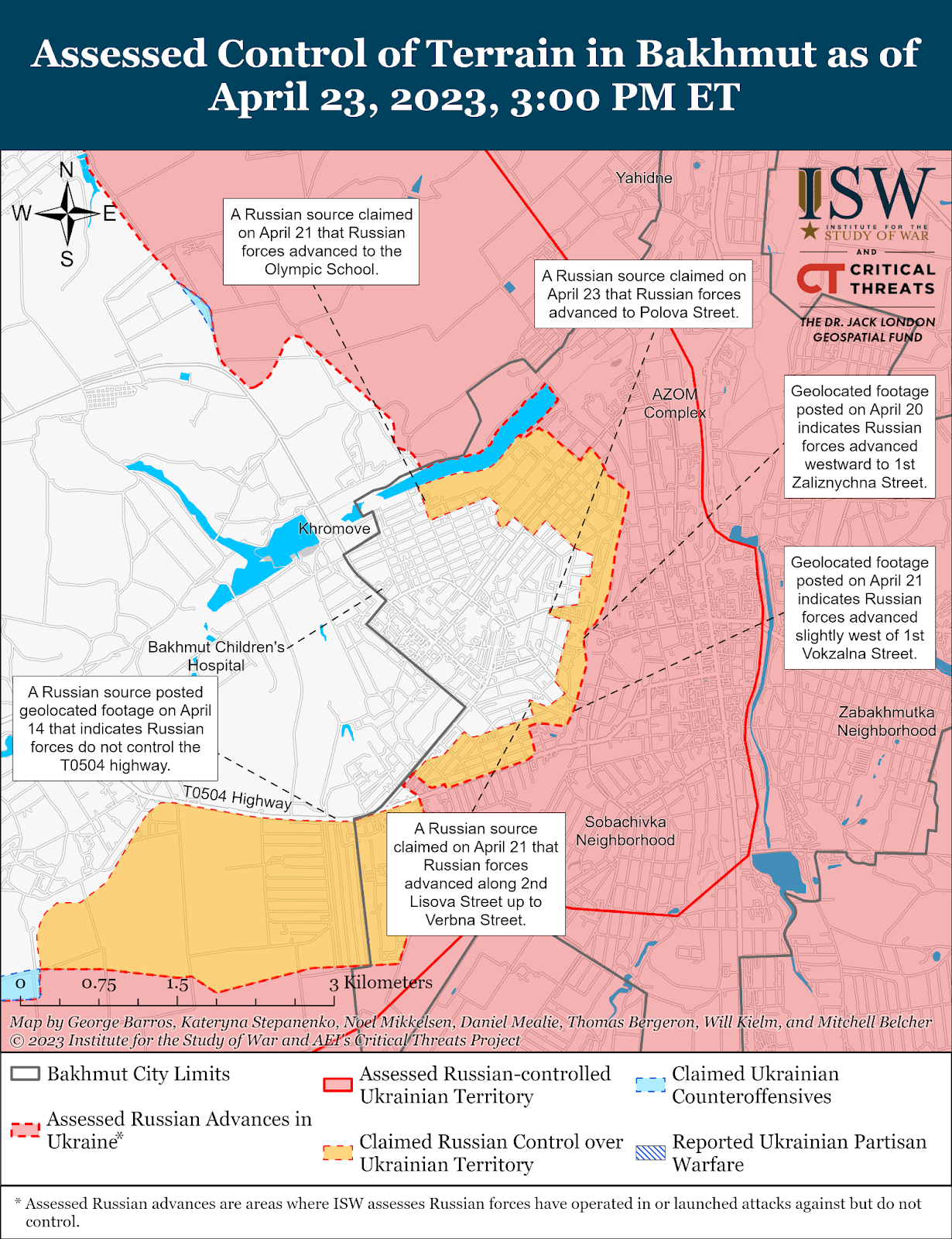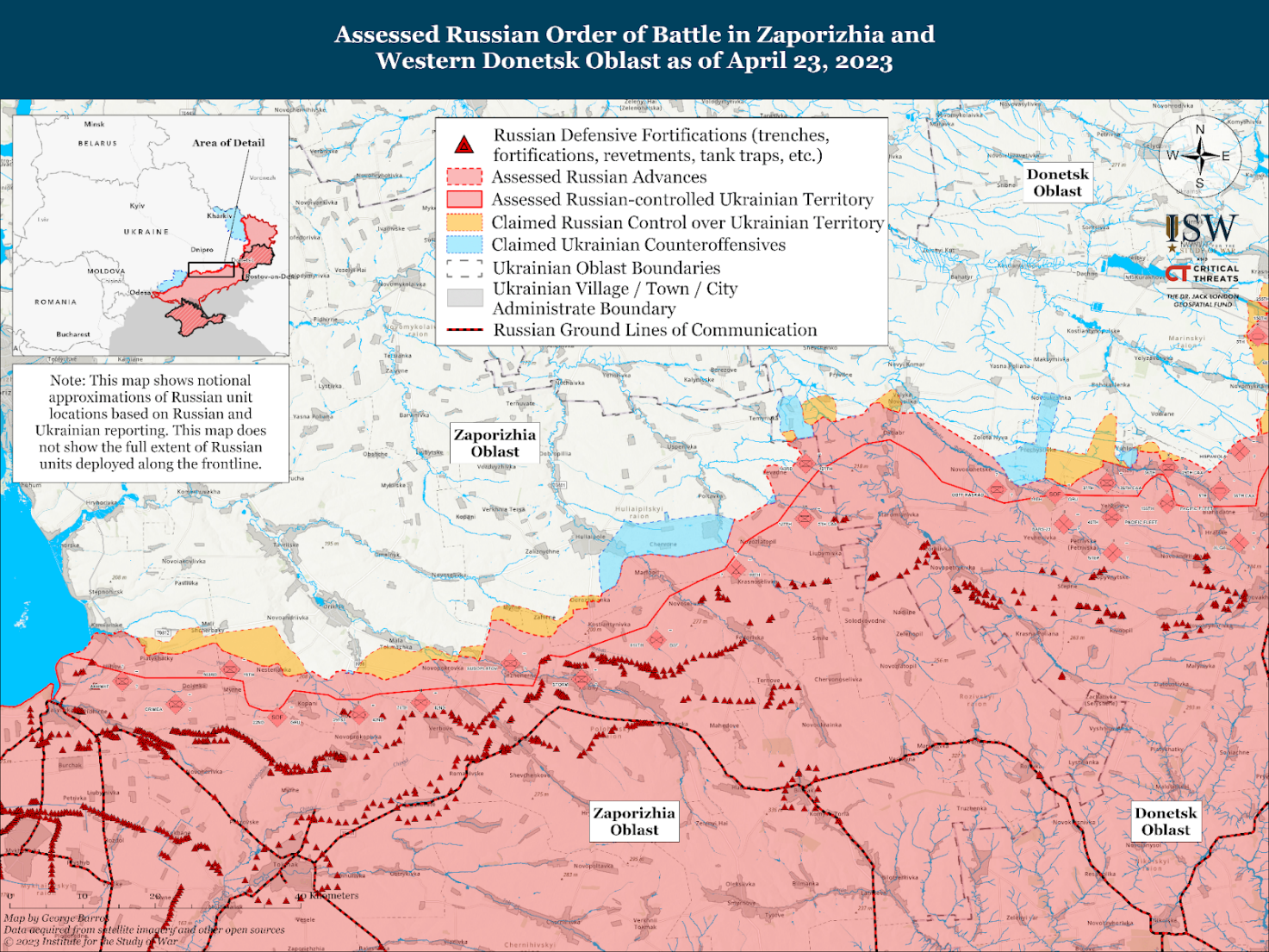Above: Belarusian milbloggers reported that Minsk is ready to accept Moscow’s tactical nuclear weapons. Belarus has upgraded its soviet-era nuke bases and prepared Su-25 aircraft capable of carrying nuclear missiles. The Belarusian MoD reported last week that troops sent to Russia to train on the Iskander mobile missile launching systems that fire nukes finished their training and returned to Belarus. (Photo: Ukrainska Pravda)
Lithuania, constantly threatened with invasion, was kind enough to donate many of its weapons systems to Ukraine. We will never forget this generosity. 🇺🇦 🤝 🇱🇹 pic.twitter.com/4dYW1Q5ZBO
— Defense of Ukraine (@DefenceU) April 24, 2023

Above: In the department of unconfirmed rumors, Kremlin sources say that a Ukrainian drone was found near Moscow with 17 kg of “Canadian explosives” attached. Better luck next time, boys and girls. (NewsUkraine24)
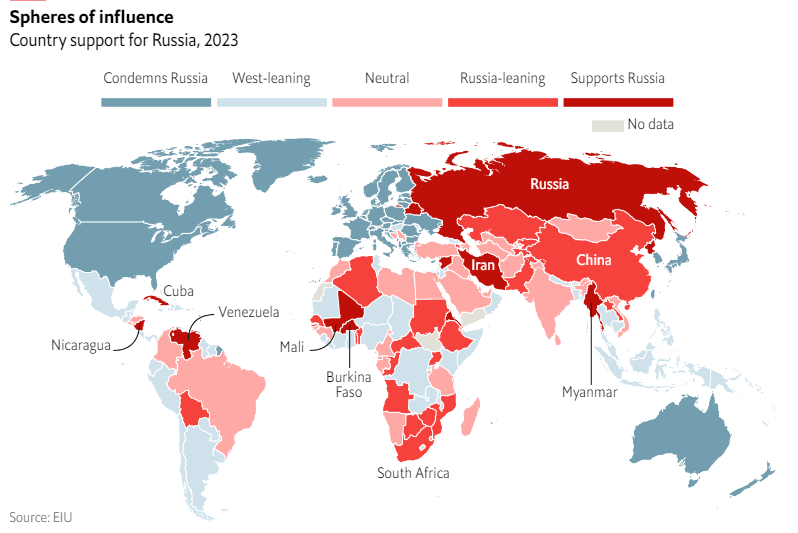
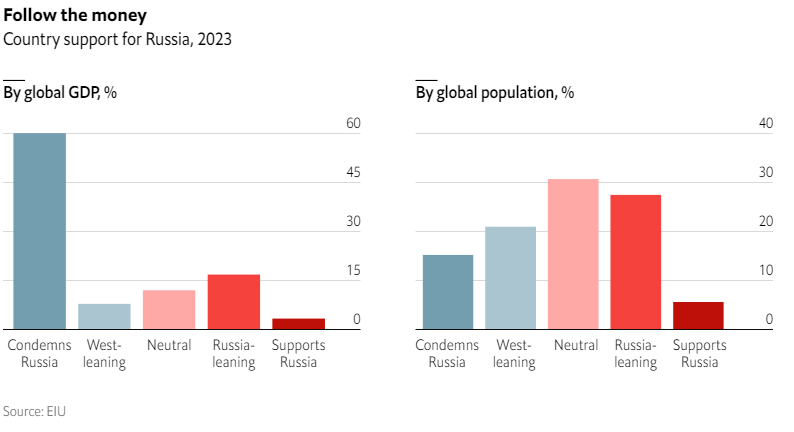
Above: The Economist reported that global support for Russia is trending positive in terms of the number of countries that are moving along the spectrum from Western-leaning towards outright Kremlin support. A majority of the shift countries are in Africa with low GDP and high population density. The conclusion is that while the trend might give Moscow bragging rights, it does nothing to help Putin avoid the many hazards on his road ahead.
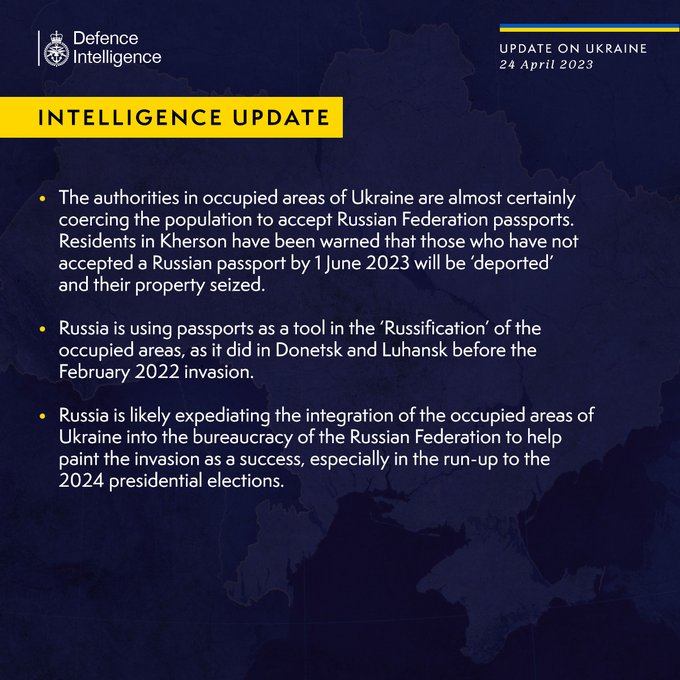
Above: UK Ministry of Defence
- In the schadenfreude story of the day, The Guardian reported on how the most dangerous elements of Russian society – prisoners recruited and pardoned by Wager to fight in Ukraine – are returning to terrorize their hometowns.
- According to a story in Politico, “The United Nations is accustomed to oddity, absurdity and a certain amount of hypocrisy. But the UN eye-rolling is hitting epic levels this month as Russia has taken over the rotating presidency of the U.N. Security Council and used it to defend its war on Ukraine.” Diplomats are watching the war-mongering state struggle to gaslight the world and it’s just not working any longer. Key powers are sending lower level representatives to some Kremlin-led sessions and walking out when the lies become too bald-faced.
ISW’S SUNDAY EDITION ON THE CURRENT INFLEXION POINT
- ISW’s special edition on Sunday examined the current inflexion point on the eve of a Ukrainian counteroffensive in terms of recent enemy operations (gains and losses), current deployment of military assets along the front on seven axes and assessment of readiness to resist a Ukrainian counter offensive.
- Russian forces are currently operating along seven axes: Kupyansk (Kherson); western Luhansk Oblast; Bakhmut;Avdiivka-Donetsk City; western Donetsk/eastern Zaporizhia; western Zaporizhia; and Kherson Oblast. . We provide a briefing of each axis in the geographic sections of the War Chronicle today.
- In general, Russian forces in Ukraine are operating in decentralized and largely degraded formations throughout the theater. Current patterns of deployment suggest that most available forces are already engaged and deployed, suggesting that the invader may have problems increasing troop strength within the counteroffensive timeframe. .
- The Russian obsession with small-scale tactical offensive operations past the point of culmination has left Russian forces ill-prepared to respond to a large-scale counter-offensive, lacking the necessary complicated command and control skills needed to hold back Ukraine. The combat experience of most Russian commanders is inadequate to prepare them well for the challenges ahead.
- The majority of the Russian units on the front have been filled out with mobilized servicemen who were called up after Ukraine’s Kherson and Kharkiv Oblast counter offensives and have no experience defending against or withdrawing from a counteroffensive. They are unlikely to be emotionally or intellectually prepared to respond to such an assault.
General Staff’s Daily Video Digest with English subtitles
Above: Damage in Belgorod, Russia, from Russian bombs. Russian losses inflicted by Russians isn’t included in the General Staff’s daily update. (CBC)
Ukrainian General Staff of the Armed Forces estimated enemy losses since February 24, 2022 (with daily additions)
- Liquidated personnel, 187,080 (+660)
- Tanks, 3,683 +8)
- Armored personnel vehicles, 7,139 (+8)
- Artillery systems/MLRS, 2,849/539 (+12/0)
- Anti-aircraft systems, 289 (0)
- Aircraft/helicopters, 308/294 (0)
- Unmanned aerial vehicles, 2413 (+11)
- Cruise missiles, 911 (0)
- Warships/boats, 18 (0)
- Vehicles and fuel tanks, 5,753 (+23)
- Special equipment, 339 (0)
Above: Occupiers fired on dozens of Ukrainian villages, towns and cities over the weekend. (Pavlo Kyrylenko)
Glory to Ukraine!
The 425th day of the Russian large-scale invasion has begun.
- The russian federation continues to ignore International Humanitarian Law, terrorizing civilians and destroying residential buildings and critical infrastructure.
- During the past day, the enemy launched 1x missile and 46x air strikes. They carried out about 60x rounds from MLRS on the positions of our troops and populated areas. Actively uses aviation, using winged aerial bombs in Luhansk, Donetsk, Zaporizhzhia and Kherson As a result, there are dead and wounded among the civilian population, destroyed and damaged private residential buildings and other civilian infrastructure.
- The threat of launching missile and air strikes on the entire territory of Ukraine remains high.
- The main efforts of the enemy are focused on conducting offensive operations on the Bakhmut, Avdiivka and Mar’yinka axes – about 60x enemy attacks were repelled. The fiercest battles continue for Bakhmut and Mar’yinka.
- During the past 24 hours, the population centers of Gremyach, Chernihiv Oblast, were shelled; Chervona Zorya, Pavlivka, Kindrativka, Timofiivka in the Sumy Oblast, as well as Hoptivka, Zelene, Neskuchne, Budarky, Milove, and Krasne Pershe in the Kharkiv
- Kupyansk axis: Dvorichna, Hryanikyvka, Masyutivka, Liman Pershiy, Kislivka and Berestov of the Kharkiv Oblast were subjected to enemy artillery fire; Novoselivske in Luhansk Oblast; Torske and Spirne of Donetsk
- Lyman axis: Makiivka, Nevske, Belogorivka of Luhansk Oblast and Torske, Dibrova, Verkhnokamianske and Spirne of Donetsk Oblast were hit by artillery fire.
- Bakhmut axis: Vasyukivka, Orihovo-Vasylivka, Markove, Hryhorivka, Bakhmut, Ivanivske, Chasiv Yar, Stupochki, Novodmytrivka, Kostyantynivka and New York of the Donetsk Oblast were affected by enemy shelling.
- Avdiivka axis: the enemy shelled, in particular, Novokalynov, Avdiivka, Severna, Tonenka, Lastochkina, Pervomaiske, Karlivka and Nevelske.
- Mar’yinka axis: Krasnohorivka, Georgiivka, Mar’yinka, Pobyeda, Novomykhailivka, and Paraskoviivka of the Donetsk Oblast came under enemy shelling.
- Shakhtars’ke axis: the enemy fired Bogoyavlenka, Novoukrainka, Ugledar, Zolota Niva, Prechistivka, and Velika Novosilka of the Donetsk
- Zaporizhzhia and Kherson axes: the enemy shelled more than 40x settlement Among them are Vremivka, Novosilka, Novopil’ of the Donetsk Oblast; Olhivske, Chervone, Charivne, Orihiv of the Zaporizhzhia Oblast; Nikopol’, Dnipropetrovsk Oblast; Tomarine, Odradokamyanka, Olhivka, Sadov, Kizomys of the Kherson Oblast and the city of Kherson. About 25x residential buildings were damaged. There are wounded among civilians.
Support the Armed Forces! United we will win! Glory to Ukraine!
Above: The Guardian featured a story on how Russian speakers in Kharkiv are meeting to study Ukrainian together. The story gives background on how the Soviets suppressed Ukrainian language through propaganda and discrimination. One Russian-speaking participant, whose parents were colonized from Russia, summed it up: “I speak the language of the oppressor. I consider Ukrainian to be my mother tongue – even though I grew up speaking Russian.”
“A period of official ‘Ukrainianisation’ followed the October revolution of 1917, with a lively avant garde, Ukrainian-language literary scene springing up in Kharkiv. But from 1933 onwards the novelists, poets, journalists and playwrights of this brief modernist flowering were brutally suppressed. Hundreds of writers were shot, deported, or sent to the gulag; others took their own lives. These trailblazing writers – the focus of the city’s Literary Museum – are known as Ukraine’s ‘executed renaissance’.”
The New York Times looked at a trend among Ukrainian “influencers” to finally switch to Ukrainian language. It has been a deep mystery that in Ukraine, 30 years after independence, the capital was still dominated by “Russian-speaking Ukrainians”. Sociologists believe that the multi-generational russo-soviet campaign to stigmatize Ukrainian as ignorant dialect and glorify Russian as the language of culture and success is still deeply rooted.
ISW ASSESSMENT OF KHARKIV-LUHANSK BORDER AXES
- Russian forces have failed to make meaningful advances in Luhansk Oblast in 2023, despite the heavy commitment of elements of at least three armies of two military districts, elements of two VDV divisions, and the support of numerous irregular formations. The forces that have been fighting along this line for the better part of four months are likely exhausted and substantially degraded. They have continued to attack, have not rotated to rest and refit, and do not appear to have prepared themselves to receive a Ukrainian offensive.
- Russian forces have constructed a hard line of fortifications along the Kharkiv-Luhansk Oblast line at a distance of between 5 and 20 kilometers behind the front line with the bulk of Russian combat power deployed forward of its fortification lines all along the front. This array suggests that Russian forces intend to withdraw from the frontline to the fortification line and defend there in case of a Ukrainian breakthrough.
- Russian forces have been pursuing limited offensive operations on the Kupyansk axis in the first few months of 2023, but have failed to make operationally significant gains and have made only occasional and localized tactical gains.
- Russia has deployed limited special forces elements along the Svatove-Kreminna line, likely to offset the lack of infantry capabilities. The Russian military command notably appears to be increasing the prominence of Russian airborne forces near Kreminna using TOS-1A “Solntsepek” thermobaric artillery systems for the first time in history.
Above: Ukrainian soldiers training near Siversk, a small city 40 km due west of occupied Lysychansk, Luhansk, and 50 km due east of Slovyansk, Donetsk. (The New York Times)
ISW ASSESSMENT OF WESTERN DONETSK AXES
- The current Russian pattern of commitment around Bakhmut suggests that the Russian military leadership is prioritizing the completion of the capture of the city before the start of the Ukrainian counteroffensive. Sustaining Wagner’s advance beyond its culmination required the Russian MoD to commit VDV formations to allow Wagner to concentrate almost entirely on the urban fight. Wagner ceded the northern and southwestern flanks to the Russian MoD.
- Russian military leadership has allocated more modern assets to Wagner in an attempt to expedite the capture of the city. About 200 Chechen “Akhmat” special purpose police arrived to combat desertion and sabotage by other Russian forces in the area, but are unlikely to have engaged in actual combat, however.
- Lines of fortifications in the Bakhmut and Donetsk City area are 5 to 20 kilometers behind the current line of contact, in principle leaving Russian forces space to withdraw through a buffer zone and man a system of defenses behind the line.
- The Russian military command has heavily committed a variety of DNR elements to the Avdiivka-Donetsk City frontline, alongside some Southern Military District and Northern Fleet units. These elements have made no operationally significant progress on this axis in 2023 beyond marginal tactical advances around Avdiivka and Marinka. DNR forces have notably been active along this axis since 2014, and the current frontline in this area is within kilometers of the line that has held for eight years.
- DNR forces in this area have particularly suffered from poor and abusive command culture, which has been greatly exacerbated by the Russian MoD’s campaign to integrate and formalize DNR forces. Russia is sending mobilized servicemen from throughout Russia to fill out DNR units with minimal training. DNR commanders badly mistreat mobilized servicemen and force them into attritional assaults with no preparation.
- In addition to conventional MoD forces, several volunteer battalions are also reportedly fighting on the Avdiivka-Donetsk City Perm Oblast “Molot” Tank Battalion, the “Wolves” Sabotage and Reconnaissance Battalion, and the “Nevsky” volunteer detachment are fighting near Avdiivka and in the Donetsk City area.
- Russian Eastern Military District elements have been committed to western Donetsk Oblast near Vuhledar since fall 2022 and have suffered continued losses during repeated failed attempts to take Vuhledar. Reports suggest that volunteer elements near Vuhledar are poorly disciplined and combat ineffective. Limited DNR elements, a GRU brigade, several volunteer battalions, and a BARS detachment are also operating near Vuhledar, notably the “Hispaniola” Battalion comprised of Russian sports fans.
Above: Widespread reports of traffic jams forming on escape routes from southern occupied areas. (The Lviv Journal)
In Sevastopol, Crimea, a night attack by 2 surface drones was reported. The video shows how one of the drones explodes inside the bay. Whether anything was damaged by the explosion is still unknown. Air defense activity was also reported. pic.twitter.com/Upy56s3bke
— Special Kherson Cat 🐈🇺🇦 (@bayraktar_1love) April 24, 2023
- Russian troops are forcibly relocating people from occupied Kherson Oblast, suggesting that Moscow’s forces might be preparing to withdraw from that area ahead of an anticipated Ukrainian counteroffensive The head of Kherson regional council said, “I have information that the evacuation starts today with an excuse of protecting civilians from the consequences of heavy fighting in the area,” adding that troops are in a looting frenzy.
- The russian occupiers continue to rob the civilian population of Ukraine, appropriating the grain harvest. In the city of Berdyansk, Zaporizhzhia Oblast, the so-called russian occupation “authorities” are trying to export stolen grain by loading it onto enemy cargo ships.
ISW ASSESSMENT OF SOUTHERN AXES
- Russian forces in southern Ukraine have prepared for defense in depth, with multiple lines of fortifications that go further into the rear. These defensive lines are likely not all heavily manned—Russian forces simply do not have the personnel to properly man fortifications in areas far removed from the frontline at force densities sufficient to withstand a determined mechanized attack.
- Russia has committed southern command elements and several irregular formations to defensive operations in western Zaporizhia. Numerous irregular formations are also present in Zaporizhia Oblast but are mainly engaged in defensive actions further in the rear. Notably, the chief of Zaporizhia occupation has his own private volunteer battalion called “Sudoplatov”, comprised of foreign volunteers and individuals forcibly mobilized from occupied Zaporizhia Oblast. Russian forces in western Zaporizhia Oblast are likely less exhausted and degraded than forces elsewhere on the front due to the largely defensive nature of operations on this front so far in 2023.
- The Russian grouping in Kherson Oblast is likely the most disorganized and undermanned in the entire theater. The original occupation forces have been reconstituted and redeployed to other areas of the front. It is highly likely that the remaining grouping on the east bank is comprised of badly understrength remnants of mainly mobilized units, although they may be slightly fresher than elements elsewhere on the frontline. However, morale issues and poor training and discipline are common in this area.
BLACK SEA FLEET NAVAL CONTRIBUTION
- The Russian military command may commit ships of the Russian Black Sea Fleet to support Russian troops attempting to defend in southern Ukraine, especially as operations move toward the coast, however, the BSF is unlikely to make a material difference in ground operations. Ukrainian forces have damaged all three Admiral Grigorovich-class BSF frigates: “Admiral Grigorovich, “Admiral Essen,” and “Admiral Makarov”.
- Satellite imagery from February 2023, suggested that the “Grigorovich” sailed to Sevastopol. Krivak-class patrol ships “Ladnyi” and “Pytlivyi” have been participating in exercises in the Black Sea in 2023. The 197th Assault Ship Brigade is comprised of two Alligator-class, three Ropucha-I, and one Ropucha-II landing ships, all of which have been reported as active as of summer 2022. These landing ships are the most relevant asset in terms of direct strike capabilities because they carry ground attack missile systems.
- The BSF also has an assortment of corvettes, minesweepers, anti-submarine ships, missile boats and landing ships in the Black Sea. These ships are unlikely to provide Russia a substantial defensive edge against any future Ukrainian counter offensives into southern Ukraine, however, as they would likely need to move close enough to the coastline that they would make themselves attractive targets.
